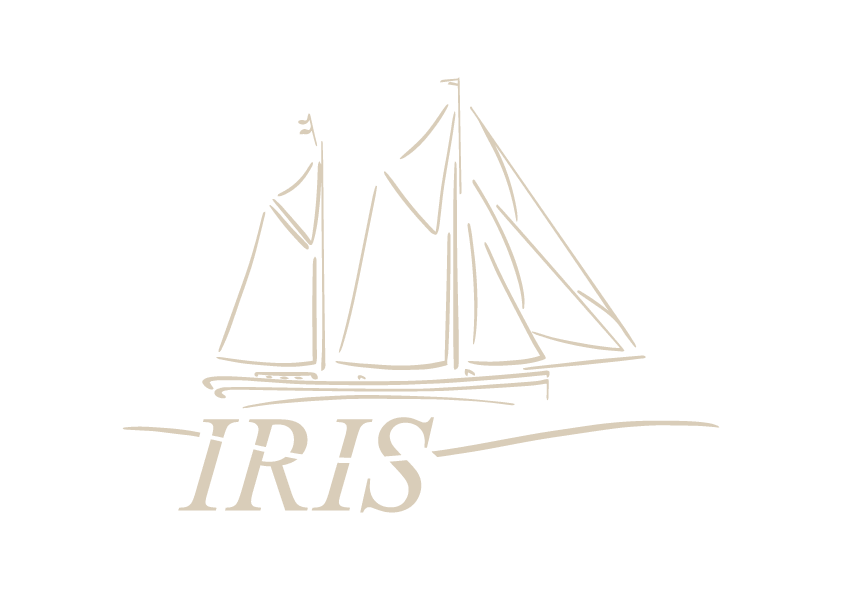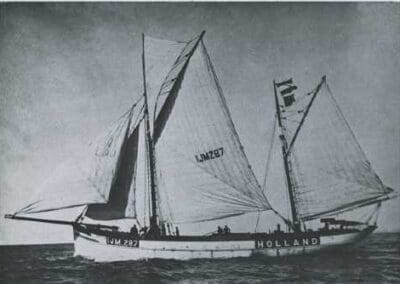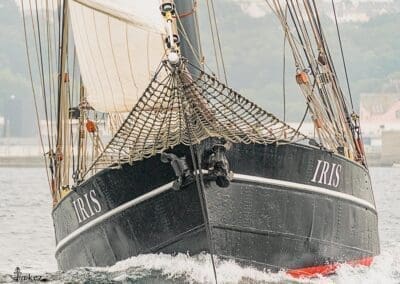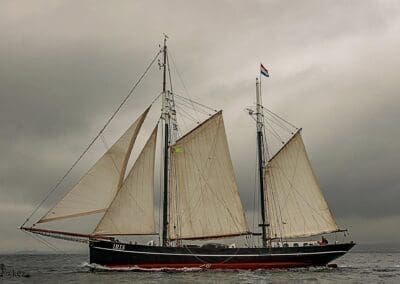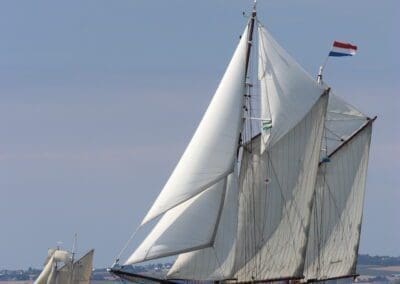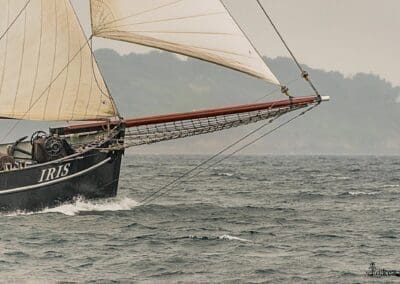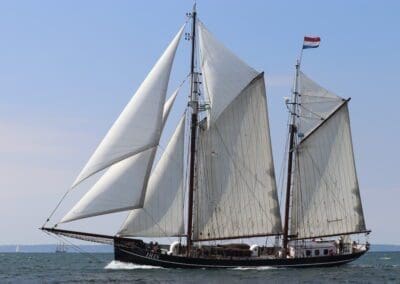The Iris
some history
Explore the Ocean!
Ship with history
She was built as a fishing vessel, sailed for decades in coastal navigation and for a quarter of a century has been one of the
finest and fastest sailing ships of Dutch professional sailing.
Her story begins in 1915, in the middle of the First World War.
Ship type
The lugger ship type was introduced to the Dutch herring fishery in 1866.
It is originally French, although the hull form is also widely known in England. It stands out for its
sharp lines, good sea behavior and especially its speed. It leaves the traditional Dutch
ships such as cornerers and tubes far behind and within ten years the entire Dutch herring fleet was replaced by luggers.
Replaced by loggers. At that time they were built only in wood.
Around 1900 the logger got competition from a bigger and stronger sister,
the iron steam lugger. The development of sailing ships in herring fishing comes to a halt.
It is World War I that changes this again. The Netherlands is neutral and can,
unlike the English, French and Germans, continue to fish. Food prices rise and fishermen
are doing good business. At the same time, oil and coal begin to become scarce.
Against this background, shipping companies order a number of new ships and they become not steam, but
sailing loggers. Wind, regardless of the course of the war, will always be there.
For this reason, the last generation of sailing luggers comes into being. They are modern steel ships,
generally slightly larger than their nineteenth-century predecessors and more heavily rigged. Several hundred of them are built in 1915 and 1916.
The shipyard
The history of shipyard “s Lands Welvaren” in Vlaardingen begins in the golden age.
In 1638 the company was founded and in the following three and a half centuries it would grow into one
of the most important shipyards of the Dutch sea fishery. In 1880, shipbuilding master
Isaäc Samuel Figee took over the shipyard and with it began a new heyday. In 1890 he builds his first
iron lugger, in 1899 the first iron steam logger.
Around this time, Figee works out a number of interesting designs. His sailing loggers, which for a few years had already exceeded the standard length of 25.25 over per
standard length of 25.25 over perpendiculars (28.00 meters over all), become both slimmer and
wider. Head and butt are more swept while overall width is nearly half a meter (to 6.66 meters)
greater. Depth is set at 2.75 meters.
This lugger type will go down in history as the “Figee logger”; not the cheapest but by far the
most beautiful and fastest sailing within a fleet of five to six hundred ships.
History of the different name
IJM 287 Pallas
In the summer of 1915 the then just founded N.V. Exploitatie Maatschappij ‘Nereus’ under
headed by C. Verver & H. Kleibrink of Bloemendaal, placed the order for the construction of three sailing loggers
at Figee in Vlaardingen. The ships are to be delivered in 1916 and will have the fishing marks
IJM 285, 286 and 287.
The IJM 287 Pallas will be the first. The vessel will be launched on January 5, 1916 and will leave for her first fishing trip at the end of May of that year.
May of that year for her first fishing trip to the waters around the 60th parallel. On June 17, she sails under
Maarten Haasnoot from Katwijk aan Zee to IJmuiden with 336 tons of salt herring on board. That
year the Pallas will market 1683 canteens of herring in five voyages, which is well above (177%) the
average catch of the sailing lugger fleet that year.
The IJM 287 Pallas will remain in service as a sailing herring logger for ten years. She is a “lucky ship” that both
gets through the war and the time after without mine explosions, collisions or groundings.
Her catches are generally above average, but around 1926 the sailing lugger as a ship type is really dated.
really dated. Hundreds of her kind have been laid up, scrapped or motorized.
Since 1920, the Pallas has been owned by our country’s largest fishing company, the Vereenigde
Exploitatie Maatschappij (VEM) in IJmuiden, and in 1926 it decided to add the sailing vessels to its fleet of several dozen loggers and trawlers. It takes three years for a buyer to presents itself.
In September 1929, the Pallas departed with three other sailing loggers behind a tug to the Swedish
Karlshamn where a shipyard will convert the hulls into cargo ships on its own account.
Aage
In 1930, the Karlshamn Skeppsvarv offered the former Pallas for sale.
The ship had two hatches, a deckhouse with a wheelhouse behind it, a fixed bowsprit and
mainly received a 104 hp auxiliary engine. As a steel motoryacht with a carrying capacity of
160 tons, it has become a modern, medium-sized coaster for the Baltic Sea area.
The new owner is Captain N.J. Møller from Svendborg, Denmark. He named the ship after
his infant son Aage.
The Aage will be a familiar face in Danish coastal shipping for more than forty years. Until 1943
she sailed for successive owners from Svendborg, then from her home port of Rønne on the island of Bornholm.
Her sailing area is the entire Baltic Sea to the Gulf of Bothnia in the northeast and western Sweden and southern Norway to the Skagerak in the south.
South Norway to Skagerak in the west.
In 1950 a new engine was installed, a 2 cylinder Grenaa glow head of 166 hp. One year later
Kaj V. Pedersen buys the cargo lugger. He is known as a good sailor and sails it across the water.
Over twenty years later, Kaj Pedersen is then past seventy and his ship begins to approach sixty
, the time has come to stop. As a coaster, the lugger begins to get too small.
The fact that the real sails have long since been replaced by a trestle with a plastic sling sail and the
wheelhouse is equipped with an autopilot and radar, cannot remedy that. Moreover, the ship is
in urgent need of major maintenance, and the elderly owner decides to put it up for sale in its
home port of Rønne.
Geesje van Urk
In this condition, Gert Loomeijer and Marileen Biekart found the former sailing lugger in the summer of 1975.
After purchase, it is renamed Geesje van Urk and sailed to Groningen. An inventory of
work at the shipyard shows that restoration of the old hull with the still original wooden deck will be
will be a major job. It began in 1978 at the Van den Berg machine factory in Lemmer. Three years
, in the spring of 1981, the Geesje van Urk was launched for the second time in her 65 years of
existence, as a sailing ship under the Dutch flag.
The old Grenaa glow-head engine that gave up the ghost in 1976 on a trip from Vlaardingen to
England, has since been replaced by a 280 hp Caterpillar (for which in 1994 a revamped GM
Detroit Diesel 320 hp in its place).
The Geesje van Urk is used as a sailing passenger ship and also for sailing and management training.
Her sailing area from the respective home ports Vlaardingen and Rotterdam, extends from
Brittany, Ireland and the Lofoten Islands in the west to the Åland Islands in the east.
In 1991-92, the ship was again extensively rebuilt and refitted, adapting it to the
class requirements for worldwide sailing.
On July 17, 2001 the Geesje van Urk was sold to Frits and Riemke Leusink, Ben Bos, Udeke Huiskamp, and
renamed Iris.
Iris
On July 17, 2001, the Geesje of Urk was sold to Frits and Riemke Leusink, Ben Bos, Udeke Huiskamp, and
christened the vessel Iris (Zeillogger Iris VOF). Of all the owners, over time Ben and Marianne Bos remained. Under their management, the Iris sailed between the Netherlands, France and England and along the Irish and Scottish coasts. Home port of the ship was the beautiful Veerhaven in Rotterdam. At the end of 2022, after 20 years, they sold the ship to Floris de Waard. Summer season 2023 then several captains sailed on the ship.
The ship has been very lucky in her histories with the loving owners who took care of her.
Since Jan. 11, 2024, Jans Beekhuizen and Liv Stammberger are proud owners. They saw the acquisition as an opportunity to preserve this beautiful sailing ship, continue its care while breaking new ground. In the future, they plan to use the ship for sailing trips on various waters (including the North and Baltic Seas).
They offer day trips as well as multi-day trips, individual bookings and group tours.
Origin of the name IRIS
IRIS comes from Greek mythology. She is the goddess of good and was sent by the chief god Zeus to bring good news to mankind. Equipped with a torch and beautiful wings, she is carried by the rainbow and is faster than the wind. The ship IRIS also wants to bring good news and is fast of its kind.
History from the Pallas to the Iris….
"Vlaardingen, Jan. 5: From the shipbuilding yard 's Lands Welvaren of mr.
I.S. Figee alhier the steel logger ship PALLAS,
built on behalf of Mr. C. Verver of Bloemendaal.
The ship will be equipped for herring fishing."
So says the Visscherijblad of the Nieuwe Vlaardingsche Courant of Wednesday, January 5, 1916.
The steel sailing lugger accommodates 8/14 crew and measures 297 GRT.
This is a typical Figee-logger, with an aft mast that tilts slightly forward.
Although no details are known about this, this ship too will have a length of 28 meters and
a width of 6.60 meters: a length-to-width ratio typical of these loggers.
The name list of herring shipping companies shows that the ship sailed that year for the NV Exploitatie
Mij 'Nereus' at IJmuiden. This shipping company had two other loggers of 105.5 GRT built in 1916 at
Figee, namely the IJM 285 JUNO and the IJM 286 VESTA.
The PALLAS, the JUNO and the VESTA formed the entire fleet of 'Nereus'.
In the annual review of the herring fishery at IJmuiden, the PALLAS does not appear in 1917.
However, the ship sailed for the same shipping company and under the same skipper.
Two of the three loggers of 'Nereus' were laid up, including the PALLAS.
The PALLAS and the VESTA were sold to the Algemeene Visscherij Mij, under the management of
J.F. Klercq. 'Nereus' ceased to exist.
Under skipper D. Roest, the PALLAS caught 1211 canteens of herring and 11 canteens of mackerel in 6 voyages.
In this year the Algemeene Visscherij Mij merged into the Vereenigde Exploitatie Mij with as its
directors A.J. Veldkamp and S. Koster. Owner of this company was the Vereenigde
Coal Trade, Shipping Department. In the same year the Exploitation and
Administratie Mij 'Shamrock 1' and thus owned a fleet of 28 ships in one year.
The IJM 287 PALLAS under skipper A. Kulk from Scheveningen caught in only 5 voyages
1672 canteens of herring and 20 canteens of mackerel.
The PALLAS remained in the hands of the VEM until 1929. Under skipper A. Kulk, she sailed July 1921,
but the third trip had to be interrupted because the helmsman had gone overboard.
"-Drowned-
The lugger, IJM 287 PALLAS of the Visscherij Exploitatie Mij at IJmuiden, arrived there with
interrupted its journey, as the helmsman J. Kulk from Scheveningen was swept overboard at sea and drowned.
fell overboard and drowned. The mate was a son of the skipper and only since
half a year married ....."
This wrote the Visscherijblad on September 6, 1921.
The PALLAS then made one more voyage under skipper A. van Duyn.
The total catch that year, with four voyages, was only 693 cants of herring and 21 cants of
mackerel.
Skipper M. van Duyn, 3 voyages, 725 canteens of herring.
That year she made only 3 voyages and landed a total of 851 canteens of herring. Skipper was
M. Haasnoot.
The fall of 1926 brought a lot of bad weather. The IJM 286 VESTA broke the aft mast in July and
lost the sloop in September in a collision with the IJM 5. On 6 October the VL 56
COPERNICUS with the loss of 14 men. The PALLAS then made her last voyage as a fisherman.
The praai reports of the 'Visscherijblad' of October 8 recount:
"By the commander of Hr. Ms. Pilot boat No. 6 in charge of policing the
fishing in the North Sea were spotted on Tuesday 5 October between 54°10' and 54°20' N and
1°45' and 2°10' E the .... and the lugger IJM 287, and the ....."
After this voyage, the PALLAS was laid up. In 1929 she reappeared in the paper.
The 'Dagblad voor IJmuiden-Velsen-Beverwijk' of Tuesday, September 17, 1929: "The steel
sailing loggers IJM 204 DINA, IJM 270 HENDRIKA, IJM 286 VESTA and IJM 287 PALLAS
of the VEM, which had been laid up in the Haringhaven for some time, have now been sold to
Sweden."
The "Fisherman's Journal" of September 20, 1929:
"Vessels sold: the sailing loggers DINA IJM 204, HENDRIKA IJM 270, VESTA
IJM 286, and PALLAS IJM 287 of the VEM at IJmuiden have been sold to a shipyard at
Karlshamn in Sweden which will convert them to cargo ships."
At the Karlshamn Skeppsvarv (owner John Carlborn), the PALLAS was converted to a
sailing freighter with auxiliary engine (104 hp).
zeilloggers IJM 204 DINA, IJM 270 HENDRIKA, IJM 286 VESTA en IJM 287 PALLAS
van de VEM, welke reeds geruime tijd in de Haringhaven waren opgelegd, zijn thans naar
Zweden verkocht."
Het 'Visscherijblad' van 20 september 1929:
"Verkochte schepen: De zeilloggers DINA IJM 204, HENDRIKA IJM 270, VESTA
IJM 286, en PALLAS IJM 287 van de VEM te IJmuiden zijn aan een scheepswerf te
Karlshamn in Zweden verkocht welke deze zal ombouwen tot vrachtschepen."
Op de Karlshamn Skeppsvarv (eigenaar John Carlborn) werd de PALLAS verbouwd tot
zeilvrachtschip met hulpmotor (104 pK).
Sold to H.L. Hansen at Svendborg.
Sold to C. Petersen at Rønne, Bornholm, owner of the flour mill there.
Tegen het eind van de jaren vijftig is de tuigage eraf gegaan.
De houten achtermast bleef staan, de voormast werd en stalen coastermast.
"Am 18.8.53, um 00.10 Uhr, passierte ich das Feuer Dameshöved. .... Nachdem ich etwa 3
Minuten wieder in Ruderhaus war, verspürten der Leichtmatrose und ich einen Stoss am
Schiff. ... .Nachdem ich mit meiner Seuerbordseite an der Backbordseite der Kutters lag,
wurden Leinen vom Kutter zu meinem Schiff herübergegeben und der Kutter Achtern und vorn
vertäut. .... dass ich den Kutter noch in flachem Gewässer aufsetzen konnte. .... und wir
hatten gerade noch Zeit auch die Vorderleinen zu lösen, als der Kutter auch schon absackte.
Wenn ich nun gefragt werde wie es zu diesem Zusammenstoss gekommen ist, so möchte ich
nochmals betonen, dass ich im dunklen Winkel der Dampferlaterne auf das Fahrzeug
zugefahren bin und dass das Ankerlicht so tief angebracht war, dass es vom Ruderhaus
verdeckt war und ich es ebenfalls nicht sehen konnte."
Klasse Veritas vervallen en onttrokken aan de zeevaart.
Begin gemaakt met de restauratie.
Voorzien van een nieuwe motor: Caterpillar 8 cylV, 280 pK.
(G.P. Loomeijer & M. Biekart). Tevens permanente bewoning.
Ligplaats Vlaardingen.
Ligplaats Rotterdam.
Romp gedurende 1 seizoen kottergroen.
Restoration of the hull midships
Equipped with a new engine: GM Detroit Diesel 8V-92N, 320 hp.
Replaced mizzen and bowsprit, overhauled foremast and spars.
Sold to F. J. Leusink in Amersfoort.
Housed in partnership between F.J. and R.H. Leusink, B.J. Bos and
U.N.J. Huiskamp and renamed IRIS.
I.S. Figee alhier is gisteren met goed gevolg te water gelaten het stalen loggerschip PALLAS,
gebouwd voor rekening van den heer C. Verver te Bloemendaal.
Het schip zal voor de haringvisserij worden ingericht."
Aldus het Visscherijblad van de Nieuwe Vlaardingsche Courant van woensdag 5 januari 1916.
De stalen zeillogger biedt plaats aan 8/14 bemanningsleden en meet 297 brt.
Het gaat hier om een typische Figee-logger, met een achtermast die iets naar voren overhelt.
Hoewel daarover geen gegevens bekend zijn, zal ook dit schip een lengte hebben van 28 meter en
een breedte van 6.60 meter: een lengte-breedte verhouding die voor deze loggers kenmerkend is.
Uit de naamlijst van haringrederijen blijkt, dat het schip dat jaar voer voor de NV Exploitatie
Mij 'Nereus' te IJmuiden. Deze rederij liet in 1916 nog twee loggers van 105,5 BRT bouwen bij
Figee, t.w. de IJM 285 JUNO en de IJM 286 VESTA.
De PALLAS, de JUNO en de VESTA vormden de hele vloot van 'Nereus'.
Het schip voer echter voor dezelfde rederij en onder dezelfde schipper.
De PALLAS en de VESTA werden verkocht aan de Algemeene Visscherij Mij, onder directie van
J.F. Klercq. 'Nereus' hield op te bestaan.
Onder schipper D. Roest ving de PALLAS in 6 reizen 1211 kantjes haring en 11 kantjes makreel.
directeuren A.J. Veldkamp en S. Koster. Eigenaar van deze maatschappij was de Vereenigde
Steenkolenhandel, afdeling Reederij. Deze slokte in hetzelfde jaar ook de Exploitatie en
Administratie Mij 'Shamrock 1' op en bezat op deze manier in één jaar een vloot van 28 schepen.
De IJM 287 PALLAS ving onder schipper A. Kulk van Scheveningen in slechts 5 reizen
1672 kantjes haring en 20 kantjes makreel.
maar de derde reis moest onderbroken worden omdat de stuurman overboord geslagen was.
"-Verdronken-
De logger, IJM 287 PALLAS van de Visscherij Exploitatie Mij te IJmuiden, is aldaar met
onderbreking van de reis binnengekomen, daar de stuurman J. Kulk uit Scheveningen op zee
overboord geslagen is en verdronk. De stuurman was een zoon van de schipper en pas sedert
een half jaar gehuwd ....."
Dit schreef het Visscherijblad op 6 september 1921.
De PALLAS maakte daarna nog één reis onder schipper A. van Duyn.
De totale vangst dat jaar bedroeg met vier reizen slechts 693 kantjes haring en 21 kantjes
makreel.
M. Haasnoot.
De herfst van 1926 bracht veel slecht weer. De IJM 286 VESTA brak in juli de achtermast en
verspeelde in september de sloep bij een aanvaring met de IJM 5. Op 6 oktober verging de VL 56
COPERNICUS met verlies van 14 man. De PALLAS maakte toen haar laatste reis als visserman.
De praaiberichten van het 'Visscherijblad' van 8 oktober vertellen:
"Door de commandant van Hr. Ms. Loodsboot No 6 belast met het politietoezicht op de
visscherij in de Noordzee zijn gepraaid op Dinsdag 5 october tussen 54°10' en 54°20' NB en
1°45' en 2°10' OL de .... en de logger IJM 287, en de ....."
Na deze reis werd de PALLAS opgelegd. In 1929 verschijnt ze weer in de krant.
zeilloggers IJM 204 DINA, IJM 270 HENDRIKA, IJM 286 VESTA en IJM 287 PALLAS
van de VEM, welke reeds geruime tijd in de Haringhaven waren opgelegd, zijn thans naar
Zweden verkocht."
Het 'Visscherijblad' van 20 september 1929:
"Verkochte schepen: De zeilloggers DINA IJM 204, HENDRIKA IJM 270, VESTA
IJM 286, en PALLAS IJM 287 van de VEM te IJmuiden zijn aan een scheepswerf te
Karlshamn in Zweden verkocht welke deze zal ombouwen tot vrachtschepen."
Op de Karlshamn Skeppsvarv (eigenaar John Carlborn) werd de PALLAS verbouwd tot
zeilvrachtschip met hulpmotor (104 pK).
zeilloggers IJM 204 DINA, IJM 270 HENDRIKA, IJM 286 VESTA en IJM 287 PALLAS
van de VEM, welke reeds geruime tijd in de Haringhaven waren opgelegd, zijn thans naar
Zweden verkocht."
Het 'Visscherijblad' van 20 september 1929:
"Verkochte schepen: De zeilloggers DINA IJM 204, HENDRIKA IJM 270, VESTA
IJM 286, en PALLAS IJM 287 van de VEM te IJmuiden zijn aan een scheepswerf te
Karlshamn in Zweden verkocht welke deze zal ombouwen tot vrachtschepen."
Op de Karlshamn Skeppsvarv (eigenaar John Carlborn) werd de PALLAS verbouwd tot
zeilvrachtschip met hulpmotor (104 pK).
Tegen het eind van de jaren vijftig is de tuigage eraf gegaan.
De houten achtermast bleef staan, de voormast werd en stalen coastermast.
"Am 18.8.53, um 00.10 Uhr, passierte ich das Feuer Dameshöved. .... Nachdem ich etwa 3
Minuten wieder in Ruderhaus war, verspürten der Leichtmatrose und ich einen Stoss am
Schiff. ... .Nachdem ich mit meiner Seuerbordseite an der Backbordseite der Kutters lag,
wurden Leinen vom Kutter zu meinem Schiff herübergegeben und der Kutter Achtern und vorn
vertäut. .... dass ich den Kutter noch in flachem Gewässer aufsetzen konnte. .... und wir
hatten gerade noch Zeit auch die Vorderleinen zu lösen, als der Kutter auch schon absackte.
Wenn ich nun gefragt werde wie es zu diesem Zusammenstoss gekommen ist, so möchte ich
nochmals betonen, dass ich im dunklen Winkel der Dampferlaterne auf das Fahrzeug
zugefahren bin und dass das Ankerlicht so tief angebracht war, dass es vom Ruderhaus
verdeckt war und ich es ebenfalls nicht sehen konnte."
Klasse Veritas vervallen en onttrokken aan de zeevaart.
Begin gemaakt met de restauratie.
Voorzien van een nieuwe motor: Caterpillar 8 cylV, 280 pK.
(G.P. Loomeijer & M. Biekart). Tevens permanente bewoning.
Ligplaats Vlaardingen.
Ligplaats Rotterdam.
Romp gedurende 1 seizoen kottergroen.
Ondergebracht in samenwerkingsverband tussen F.J. en R.H. Leusink, B.J. Bos en
U.N.J. Huiskamp en herdoopt IRIS.
SAILING AREAS SUMMER TRIPS ABROAD…
1981 – Denmark, western Sweden
1982 – Denmark, western Sweden, southern Norway
1983 – Denmark, Southern Norway
1984 – South and East England
1985 – West Norway, South and East England, North Germany, Cutty Sark race, Herring trip
1986 – South and West Norway, South and East England, Onion Race
1987 – Denmark, South and West Norway, Gotland, Öland
1988 – Bornholm, East Sweden, Ǎland archipelago, Gotland, Öland
1989 Southern England, Scilly’s, Channel Islands
1990 – Western Norway
1991 – Netherlands
1992 – Caledonian Canal, West Scotland, Hebrides, Orkneys
Race of the Classics
1993 – South England, Channel Islands.
1994 – Western Norway
1995 – Netherlands, Race of the Classics, Sail Amsterdam
1996 – West Ireland, West Scotland, Orkneys, Shetland Islands, West Norway, Race of the Classics, Bristol ’96
1997 – West and North Norway, Lofoten Islands
1998 – East England, Race of the Classics
1999 – East England
2000 – East England, Channel Islands, Brittany, Northern Germany, Race of the Classics, Brest 2000, Vegesack
2001 – East England, Race of the Classics
